PAPER 1
THOERY
SECTION A
Answer all questions in this section. For each question select the most correct option and write the letter representing it in the box provided.
1. Which of the following processes need energy?
A. Osmosis
B. Diffusion
C. Plasmolysis
D. Active transport
2. What is the normal blood sugar level in an adult person?
A. 140 mg/ 100cm3
B. 100mg/ 100 cm3
C. 90 mg/ 100 cm3
D. 80 mg/ 100 cm3
3. The diagram in figure 1 is of a transverse section of a plant part.
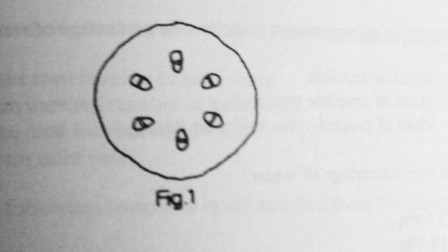
From which one of the following was the section taken? A
A. Monocotyledonous stem.
B. Monocotyledonous root.
C. Dicotyledonous root.
D. Dicotyledonous stem.
4. Which one of the following represents a reflex are?
A. Receptor - motor neuron - central nervous system - sensory neuron - effectors.
B. Receptor - sensory neuron - effectors - central nervous system - motor neuron.
C. Receptor - central nervous system - motor neuron - sensory neuron - effectors.
D. Receptor - sensory neuron - central nervous system - motor neuron - effectors.
5. The following are characteristics of insects.
(i) They undergo complete metamorphosis.
(ii) They have 1 or 2 pairs of wings
(iii) They have 3 pairs of jointed legs.
(iv) Their bodies are divided into 3 main parts.
(v) They posses exoskeletons.
Which of them are common to all insects?
A. (iii), (iv) and (v)
B. (i), (ii) and (iii)
C. (i), (iii) and (v)
D. (iii), (ii) and (v)
6. Which one of the following combination of words about amoeba are related?
A. Pseudopodia, reproduction
B. Nucleus, movement
C. Contractile vacuole, water
D. Ectoplasm, digestion
7. The results of an experiment to determine percentage of water in a sample of soil are shown below:
Mass of crucible = 15g
Mass of crucible plus soil = 30 g
Mass of crucible plus soil after drying = 25g
What is the percentage of water?
A. 33.3%
B. 18.7%
C. 66.7%
D. 20.0%
8. Which of the following reasons supports natural feeding of baby on mother's milk? Mother's milk is
(i) Easy to digest.
(ii) Made up mainly of carbohydrates.
(iii) Contains correct antibodies.
(iv) Fosters relationship between mother and baby.
A. (i) and (ii)
B. (ii) and (iii)
C. (ii), (iii) and (iv)
D. (i), (iii) and (iv)
9. The milk teeth in humans consist of
A. Incisors only.
B. Incisors and canines.
C. Incisors, canines and premolars.
D. Incisors and premolars.
10. Which one of the following is not transported in blood?
A. Amylase
B. Urea
C. Insulin
D. Sodium chloride
11. Which one of the following is not a primary function of roots?
A. Conduct water and mineral salts.
B. Anchor the plant into the soil.
C. Store food and water.
D. Absorb water and mineral salts.
12. Within an ecosystem, the total number of secondary consumer must be
A. Less than the total number of herbivores.
B. Greater than the total number of herbivores.
C. Equal to the total number of producers.
D. Constant year after year.
13. Which one of the following hormones is not secreted from the pituitary gland?
A. Gonadotrophic hormone
B. Luteinizing hormone
C. Progesterone hormone
D. Follicle stimulating hormone
14. Why is it necessary to keep both eyes open when you are using a monocular microscope?
A. Straining one eye is avoided
B. One eye is set on the drawing paper
C. It enables one to see the object clearly
D. It eases the control of the adjustment knobs
15. Which one of the following food substances are not changed by the gut enzymes?
A. Lipids and vitamins
B. Minerals and vitamins
C. Minerals and disaccharides
D. Lipids and lactose
16. The structures in insects that serve as respiratory surfaces for gaseous exchange are
A. Trachea
B. Bronchioles
C. Tracheoles
D. Spiracles
17. A man's urine gave a positive test with Benedict's solution. What is the best deduction about this man?
A. He had been eating a lot of sugar.
B. There was too much insulin in his blood.
C. There was too much glycogen in his blood
D. He was suffering from diabetes.
18. Figure 2 below is a diagram showing a plan of the pentadactyl limb
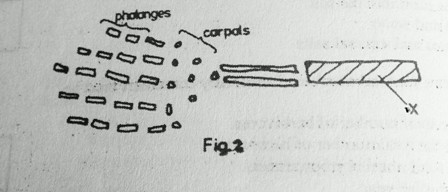
What part is represented by letter X?
A. Femur
B. Humerus
C. Radius
D. Ulna
19. What do the rhizobium bacteria gain in their association with leguminous plant?
A. Air
B. Heat
C. Shelter
D. Nitrates
20. Which of the following is the best advantage of crop rotation?
A. It helps reduce soil erosion.
B. The growth of weeds is brought under control.
C. It prevents exhaustion of particular mineral salts from the soil.
D. It helps improve soil conditions.
21. Which one of the following events does not occur following the contraction of the ventricles in mammalian heart?
A. Blood flows from ventricles into arteries.
B. The blood pressure increases in the aorta.
C. Artrio-ventricular valves open
D. Arterial valves open.
22. Which of the following mineral elements are for bone formation?
A. Iodine, sodium and calcium.
B. Iron, fluorine and calcium.
C. Phosphorus, sodium and fluorine.
D. Calcium, fluorine and phosphorus.
23. What is the function of albumen in an egg? It
A. Is a source of fat and protein for the embryo?
B. Is a source of protein and water for the embryo.
C. Suspends the embryo.
D. Stores embryo's excretory products.
24. A heterozygous red flowered plant (Rr) is crossed with a homozygous white flowered plant (rr). If R is dominant over r, what will be the phenotypes of the off springs?
A. All red
B. All white
C. Pink and white
D. Red and white
25. The dry fruit which splits open along both sutures in
A. A follide
B. A capsule
C. An Achene.
D. A legume.
26. Which one of the following structures is not essential in the life of a tadpole?
A. Lungs
B. Horny jaws
C. Gills
D. Tail
27. The diagram in figure 3 below represents the frequency of occurrence of a character in human population.
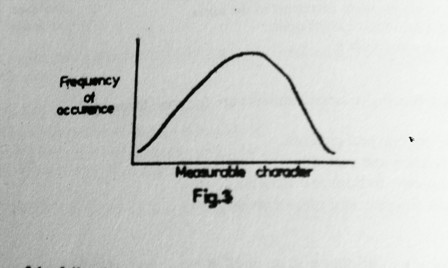
Which one of the following characters in the population does not conform to this pattern?
A. Height
B. Weight
C. Length of feet
D. Eye color
28. Which of the following is not a function of the liver?
A. Storage of vitamins.
B. Manufacture of plasma proteins
C. Storage of proteins
D. Formation of bile
29. Which of the following cells in the leaf contain the least number of chloroplasts?
A. Palisade cells
B. Guard cells
C. Epidermal cells
D. Spongy mesophyll cells
30. Which one of the following organisms is not a heterotrophy?
A. Mushroom
B. Alga
C. Tick
D. Grass hopper
SECTION B
Answer all questions in this section. Answer must be written in the spaces provided.
31. a) What do you understand by the following terms?
(i) Habitat
(ii) Ecosystem
b) There are four possible atrophic levels that can exist in a food chain. State them below.
(i) ........................................................................................................................
(ii) ........................................................................................................................
(iii) .................................................................................................................
(iv) .............................................................................................................
c) give an example of food chain consisting of four levels of organisms found in a grassland.
d) Construct a diagram of a food web which may exist in a freshwater lake in Uganda, comprising of the following organisms:
Tadpole, Green alga, Heron, Saprophytic bacteria, small fish, big fish and mosquito larvae.
32. In an experiment, a long winged male drosophila was crossed with a short winged female drosophila. All the offspring in the F1 generation were long winged. When two members of the F1 generation were mated, the F2 generation consisted of 62 long winged flies and 21 short winged flies.
a) Suggest an explanation why all the F1 generation flies were long winged.
b) (i) What type of flies would develop from a mating between short winged flies in the second generation?
(ii) Give a reason for your answer.
c) Mating between a short winged fly in F2 generation with a long winged fly in F1 generation produced 90 flies. How many of them long winged? Show your working.
33. The diagram in figure 4 shows part of the body of a man.
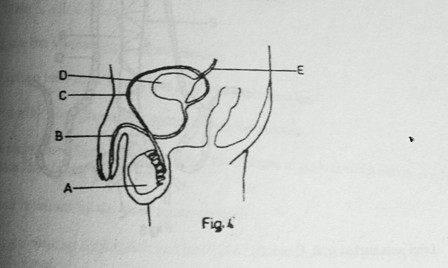
a) Name the parts labelled A to E.
A .............................................................................................................
B .............................................................................................................
C .............................................................................................................
D ............................................................................................................
E ............................................................................................................
b) (i) Name the hormone made in the male brings about the secondary sexual characteristics.
(ii) On the diagram, write H where the hormone is made.
(iii) Name two secondary sexual characteristics in the human male.
c) What is the function of part D?
d) From which organ would fluid in the tube E come from?
34. The diagram in figure 5 shows the structure of a villus.
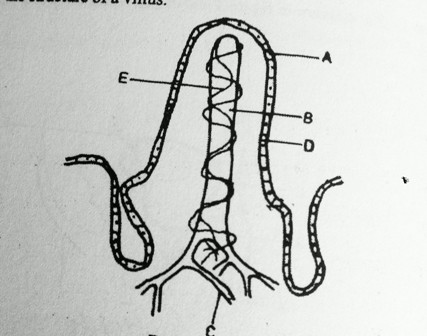
a) Label parts marked A, B, C and D.
A ...........................................................................................................
B ............................................................................................................
C ..........................................................................................................
D ..........................................................................................................
b) What food substances enter
(i) A?
(ii) B?
c) State two factors which make a villus an effective absorbing structure.
(i) ..................................................................................................
(ii) ..................................................................................................
d) How does the absorbed food in B reach the general circulation?
e) State two nutrients which are absorbed in the gut before reaching the villus.
(i) ...................................................................................................
(ii) ..................................................................................................
SECTION C
Answer any two questions.
35. a) What is soil erosion?
b) State the various types of soil erosion.
c) Explain how man's activities may lead to soil erosion.
36. a) Describe how plants lose water through their leaves.
b) Describe two features of plants and two features of animals which help them reduce water loss in dry conditions.
37. a) What is meant by the word metamorphosis?
b) Using a written description and labelled diagrams, describe the life cycle of a grasshopper.
38. a) What is respiration?
b) State three differences between aerobic and anaerobic respiration.
c) Describe gaseous exchange in a frog.
